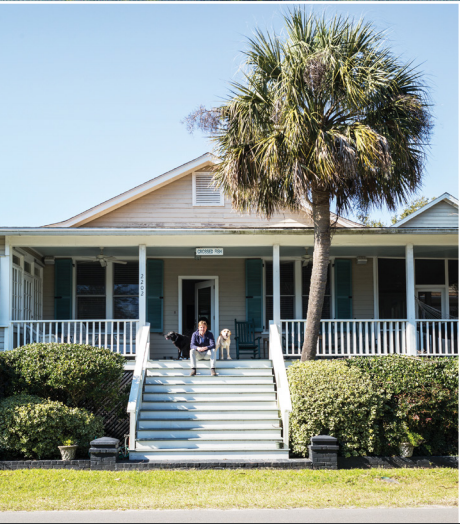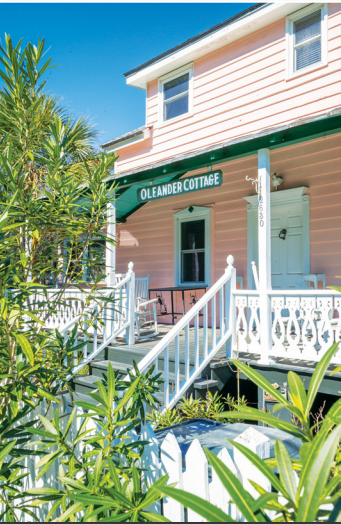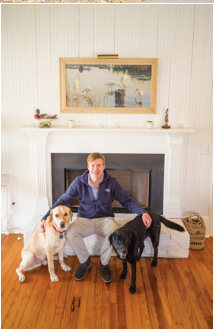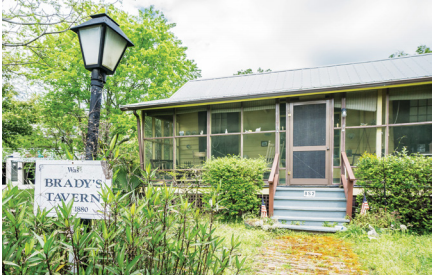Storied Structures
Historic homes dot Sullivan’s Island, with stories that range from sardine companies to six generations in a centennial. By Margaret Pilarski. Photos by Steve Rosamilia.
A painting of Brady’s Tavern by Peggy Hughes.
In the early days of Sullivan’s Island, mail could simply be addressed with a home’s name. Today the post office requires a few more details to identify an envelope’s destination but naming a beach home is a tradition that’s not going anywhere. Spot a sign? There’s probably a story. Whether the name comes from an old business, local geography, or just a special person, these homes have a history that’s worth a second glance.
OLEANDER COTTAGE
Harold Holt on the steps of Crossed Fish.
Just like some folks who move to Sullivan’s Island from “of,” some homes end up here too. Such is the case of Oleander Cottage, originally built to house attendees at the South Carolina Inter-State and West Indian Exposition of 1901– 1902, which took place in what is modern-day Hampton Park in downtown Charleston. After the fair, the exposition-built homes were put on barges and floated to Sullivan’s Island.
Oleander Cottage, Cathy Curtis’s childhood summer home
For Cathy Curtis, the cottage was a childhood summer home that felt eons away from civilization. “It was like you moved to another state—we never went ‘into the city.’ My dad would commute to work,” she says. “One of my earliest memories at Oleander Cottage is my great uncle Leo chopping a chicken’s head of on a stump in the side yard. The headless chicken ran all around the yard before dropping dead. Made an impression on a three-year-old!”
For entertainment, Curtis and her sister would sit on the porch and “play cars”—which entailed simply guessing the color of the next car. “There wasn’t the traffic there is now,” she explains. Tough the cottage had been in her family for years, they made the decision to sell in the 70s.
WILLIE’S WHISTLE STOP
Willie’s Whistle Stop.
Today, Cathy Curtis isn’t too far away from the childhood magic of Oleander Cottage. Her current home, Willie’s Whistle Stop, was le f to Curtis by her Uncle Willie, her mother’s brother and favorite uncle. “I had no idea that I was going to inherit the house and be the executrix of his estate! What a surprise,” she says. “He dropped dead in the living room of my house the month before his 90th birthday. When he was feeling well, which was most of the time, he constantly whistled. Since he died in the house, the whistling stopped here and that is how I got the name—I wanted his name on the house.”
Cathy Curtis inside Willie’s Whistle Stop.
Built in 1906, Curtis still has a copy of the home’s building permit written in longhand. “Uncle Willie bought [the home] from my uncle Henry. Uncle Henry paid $17,000 for it and Willie thought he got ripped off because he bought it [from him] for $23,000.” Today the bathrooms are all indoors, but the house’s angles still catch the island breezes, including the ones from an addition that Curtis initiated. “I added on a screen porch that gives me a view of the back yard—I love to sit out there and watch storms come in. The yard is a half-acre and I keep my four beloved chickens there that lay blue and green eggs.”
CROSSED FISH
Harold Holt and dogs inside Crossed Fish.
Named by a former owner of the house whose sardine company was called Crossed Fish, the home on the site of the old Atlantic Beach Hotel was built in 1925. “My parents, Kitty and Ed Holt, bought the house in 1999 from Sally and Jesse Ellington a for it was only on the market for a day,” Harold Holt, who shares the home with his brother Edward and sister Katherine, says. Two blocks from the beach and a block from nearby restaurants, it’s been a family gathering spot for years, but also a symbol of small-town closeness due to inadvertently sharing the space with friends.
Brady’s Tavern today.
“Over the years we found that many friends of our family had rented Crossed Fish before we owned it. Les and Barbara Robinson rented it at one point, and Jay and Jane Keenan rented it not long a for them. Both couples told us great stories when they lived there—one of the most interesting stories was when the house almost burned down in 1973 when the old Post Office caught on fire behind it. Luckily it was saved,” Holt says. Although the family has added on about 1,200 additional square feet, they were careful to add to the back of the home so as not to disturb the original 1925 design of the front. “It has always been a very social house being so close to the bars and restaurants, but it’s also a spot where you can chill out and enjoy quiet time,” Holt says. “We plan on keeping the house for many years to come.”
BRADY’S TAVERN
Although not the Brady family, six generations of a single family have kept this structure’s name in honor of a former tavern rumored to have been run out of the building. The current family’s history here dates to 1911, when James T. Molony and Margaret Hartnett Molony bought the house from Ann La fan.
James and Margaret’s daughter, Helen Molony, then married Arthur B. Moore, and their daughters—Margaret, Ann, and Jimmy—grew up in the home during the mid-century.
Jimmy remembers when “in the 1940s the town put in water and sewer lines, so Daddy added a bathroom and another bedroom to the house.” The third-generation sisters were eager participants in the operation of the bridge, too. “We would help Mr. Limbaker, the bridge operator, turn the gears to open the swing bridge. Te boys would jump on to the opening center and ride until the bridge closed again. Daddy would play cards at the house with Mr. Limbaker until boats sounded their horns to have the bridge open,” Margaret Moore Shuman says.
Ann Enright Moore remembers the popularity of one particular feature of the home: “Everyone liked to swing on the bench swing Daddy made for the front porch. Children would get the swing going fast and pretend to be traveling to Charlotte or New York,” she says. Sitting to watch travelers upon the sea never got old for the imaginative sisters, either. “The front porch is a great place to see ships coming and going in the harbor. The hospital ship seen during World War II—white with a red cross—was beautiful, especially all lit up,” Margaret Moore says. With the house dating over 100 years, the family celebrated a collective centennial of its Sullivan’s Island life in 2011. Today the sixth generation still enjoys the home in the summer.








